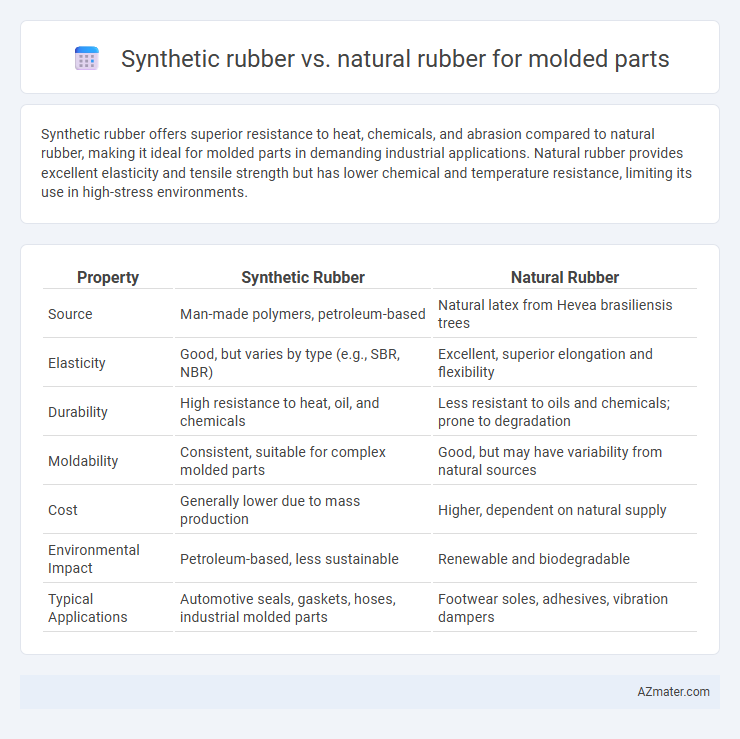Synthetic rubber offers superior resistance to heat, chemicals, and abrasion compared to natural rubber, making it ideal for molded parts in demanding industrial applications. Natural rubber provides excellent elasticity and tensile strength but has lower chemical and temperature resistance, limiting its use in high-stress environments.
Table of Comparison
| Property | Synthetic Rubber | Natural Rubber |
|---|---|---|
| Source | Man-made polymers, petroleum-based | Natural latex from Hevea brasiliensis trees |
| Elasticity | Good, but varies by type (e.g., SBR, NBR) | Excellent, superior elongation and flexibility |
| Durability | High resistance to heat, oil, and chemicals | Less resistant to oils and chemicals; prone to degradation |
| Moldability | Consistent, suitable for complex molded parts | Good, but may have variability from natural sources |
| Cost | Generally lower due to mass production | Higher, dependent on natural supply |
| Environmental Impact | Petroleum-based, less sustainable | Renewable and biodegradable |
| Typical Applications | Automotive seals, gaskets, hoses, industrial molded parts | Footwear soles, adhesives, vibration dampers |
Introduction to Synthetic and Natural Rubber
Synthetic rubber, produced through polymerization of petrochemical monomers such as styrene and butadiene, offers consistent properties, enhanced durability, and resistance to oil, heat, and abrasion, making it ideal for molded parts in industrial applications. Natural rubber, derived from latex harvested from rubber trees (Hevea brasiliensis), provides excellent elasticity, tensile strength, and resilience but tends to degrade when exposed to heat, ozone, and certain chemicals. The choice between synthetic and natural rubber for molded components depends on specific performance requirements, environmental exposure, and cost-effectiveness.
Key Properties of Synthetic Rubber
Synthetic rubber used in molded parts offers enhanced chemical resistance, superior abrasion and tear strength, and consistent performance across a wide temperature range compared to natural rubber. Key properties include excellent elasticity, resistance to oils, fuels, and solvents, and better aging stability, making it ideal for automotive, industrial, and consumer applications. These advantages enable synthetic rubber to maintain durability and flexibility under harsh environmental conditions where natural rubber may degrade.
Key Properties of Natural Rubber
Natural rubber exhibits exceptional elasticity, tensile strength, and resilience, making it ideal for molded parts requiring flexibility and high tear resistance. Its superior abrasion resistance and excellent grip underscore its suitability for dynamic applications like automotive components and industrial seals. Despite sensitivity to heat and aging compared to synthetic rubber, natural rubber's biodegradability and renewable sourcing offer environmental advantages in molded part manufacturing.
Comparison of Physical Strength
Synthetic rubber exhibits superior tensile strength and abrasion resistance compared to natural rubber, making it ideal for high-performance molded parts. Natural rubber offers excellent elasticity and tear resistance but is more susceptible to degradation from heat, ozone, and oils. The enhanced chemical stability and durability of synthetic rubbers, such as styrene-butadiene (SBR) and nitrile rubber (NBR), provide longer service life and reliability in demanding applications.
Chemical Resistance: Synthetic vs Natural Rubber
Synthetic rubber exhibits superior chemical resistance compared to natural rubber, making it ideal for molded parts exposed to oils, acids, and solvents. Natural rubber tends to degrade or swell when in contact with many chemicals, limiting its use in harsh chemical environments. This enhanced chemical resistance of synthetic rubber extends the lifespan and reliability of molded components in industrial applications.
Cost Efficiency and Availability
Synthetic rubber offers greater cost efficiency for molded parts due to consistent pricing and scalable production, reducing the impact of market fluctuations seen in natural rubber. Its widespread availability ensures steady supply chains, minimizing downtime in manufacturing processes. Natural rubber, while renewable and biodegradable, often faces price volatility and limited regional sourcing, impacting cost stability and availability for high-volume production.
Durability and Lifespan in Molded Parts
Synthetic rubber offers superior durability and extended lifespan in molded parts due to its enhanced resistance to heat, chemicals, and ozone compared to natural rubber. Natural rubber provides excellent elasticity and tear resistance but degrades faster under harsh environmental conditions, leading to shorter service life. For applications requiring long-term durability and exposure to demanding environments, synthetic rubber variants such as nitrile or EPDM are preferred for molded components.
Environmental Impact and Sustainability
Synthetic rubber, derived primarily from petrochemicals, has a higher carbon footprint and lower biodegradability compared to natural rubber, which is sourced from renewable rubber trees and offers better environmental sustainability. Natural rubber exhibits superior biodegradability and carbon sequestration capabilities during cultivation, making it a preferred choice for eco-friendly molded parts. However, advances in bio-based synthetic rubbers are improving sustainability profiles by reducing reliance on fossil fuels and enhancing recyclability.
Typical Molded Part Applications
Synthetic rubber, such as nitrile and silicone, is widely used in molded parts for automotive seals, gaskets, and industrial hoses due to its excellent oil resistance and temperature range. Natural rubber remains preferred in applications like vibration dampers, footwear soles, and flexible couplings because of its superior elasticity and abrasion resistance. Molded parts requiring chemical stability and consistent performance under harsh conditions typically rely on synthetic variants, while natural rubber molds excel in dynamic, high-flex environments.
Choosing the Right Rubber for Molded Parts
Selecting the ideal rubber for molded parts hinges on the specific performance requirements and environmental conditions of the application. Synthetic rubber, such as nitrile or silicone, offers superior resistance to heat, oils, and chemicals, making it suitable for automotive seals and industrial gaskets. Natural rubber excels in elasticity and tensile strength, making it preferred for applications requiring high flexibility and tear resistance, like footwear soles and vibration dampers.

Infographic: Synthetic rubber vs Natural rubber for Molded part
 azmater.com
azmater.com